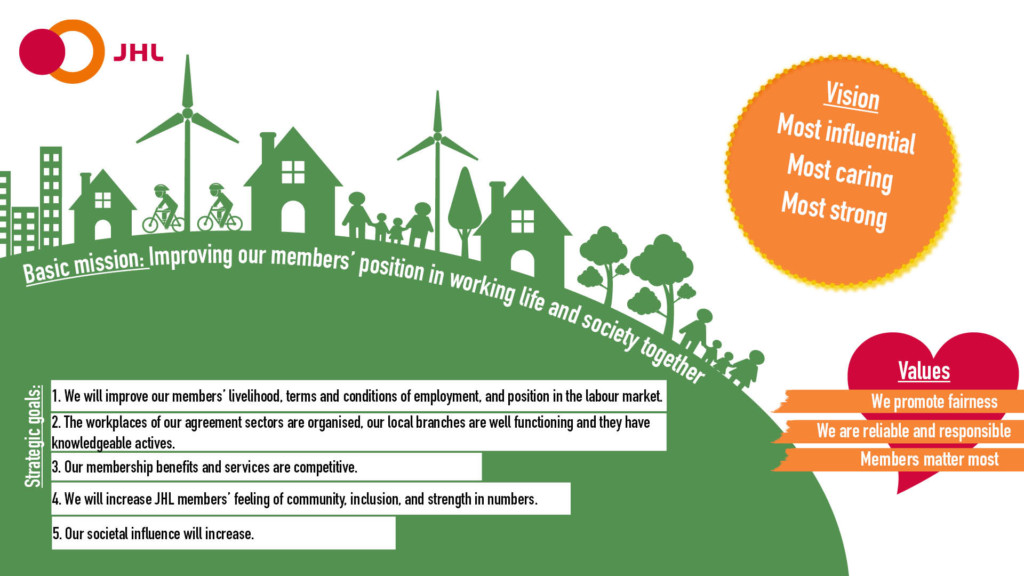Our e-services may have short interruptions today between 4 pm and 4.30 pm. Interruptions may occur in myJHL, omaYhdistys, course registration and joining JHL. We apologise for the inconvenience!
About JHL
JHL is a trade union with a mission to improve and defend its members’ terms and conditions of employment, change working life in a positive direction, and promote equality in working life.
JHL is the Finnish acronym for Trade Union for the Public and Welfare Sectors (Julkisten ja hyvinvointialojen liitto). We are Finland’s largest trade union of the public sectors. Our members represent close to a thousand occupations. JHL uncompromisingly defends the interests and rights of its entire wide range of occupations in working life.
JHL in figures
- Approximately 165,000 members
- Approximately 400 local branches
- Approximately 8,000 people with a position of responsibility
- Approximately 1,000 occupational titles
- Membership fee of trade union and unemployment fund: 1,1%
- The union’s most important economic data (results and balance sheet 2023, in Finnish)
- Altogether, JHL negotiates about 100 collective agreements in the public and private sectors.
- The Union Council is JHL’s highest executive body. It has 120 elected representatives: 80 from the municipal sector, 35 from the private sector, 4 from the state and 1 from the church sector. Its term of office is five years.
- JHL’s Executive Committee consists of the union’s president, chief executive officer and 23 members.
- Central office in Helsinki and 8 regional offices
- The organisational member unions are the Finnish Non-Commissioned Officers’ Union, the Border Security Union, the Finnish Customs Officers’ Union and the Finnish Prison Officers’ Union.
JHL’s strategy and service promise

Trade Union JHL’s basic mission is concise but demanding: Improving our members’ position in working life and society together, and looking after our members.
JHL’s operation as a trade union is guided by these three values:
- Members matter most.
- We promote fairness.
- We are reliable and responsible.
We look after our members’ interests with active protection of interests and by being alert at negotiation tables. We also ensure that workplaces have competence related to protection of interests.
As a trade union, JHL helps its member branches operate even better. We train knowledgeable actives that are an invaluable part of protection of interests.
Five strategic goals
- We will improve our members’ livelihood, terms and conditions of employment, and position in the labour market.
- The workplaces of our agreement sectors are organised, our local branches are well functioning and they have knowledgeable actives.
- Our membership benefits and services are competitive.
- We will increase JHL members’ feeling of community, inclusion, and strength in numbers.
- Our societal influence will increase.
JHL wants to look after its members, which is why we’ve given a service promise (in Finnish). We are present in your workplace and take care of things smoothly. It’s easy to get in touch with us, we listen to our members when encountering them and agree on how to take the matter forward together.
JHL’s organisation
Trade Union JHL is made up of branches, Union Council, Executive Committee, central office and regional offices. The organisational member unions are JHL’s negotiation partners, the unemployment fund and JHL Institute are an important part of JHL’s services.

History of JHL in brief
JHL was founded on 22 November 2005. When the trade unions providing public services became merged, the objective was to strengthen the negotiation positions in various agreement sectors and at various levels of negotiation, especially in the private welfare service sector. Another objective was to increase advocacy in society. Clearer guidelines for becoming organised, and maintaining high-quality member services were considered to be two important factors.
The Trade Union for the Public and Welfare Sectors JHL was founded by the SAK-affiliated public-sector unions Municipal Workers’ Union, State and Special Employees’ Union and Joint Organisation of State Employees. When JHL was founded, the unions that joined JHL as organisational members were the Coastguard Union (currently known as the Border Security Union), the Finnish Customs Officers’ Union and the Finnish Prison Officers’ Union.
The Municipal Workers’ Union, founded in 1931, was Finland’s largest trade union in the public sector. The majority of employees producing municipal services were members of the Municipal Workers’ Union.
The State and Special Employees’ Union (founded in 1929) united employees working for the Finnish state, its institutions and limited companies, in addition to employees working in private-sector health and social services.
The Finnish Non-Commissioned Officers’ (NCOs’) Union became JHL’s organisational member in 2008.
In 2010, the Railway Workers’ Union made a decision to join JHL. A joint organisation for railway employees was founded. At the beginning of 2012, the railway employees became JHL members.
Public services
… are services provided by the Finnish state, municipalities and wellbeing services counties. These services include health services, schools, research institutions, police, road maintenance, day care, services for the elderly, office and library services.
Private welfare services
… are services provided with tax revenues, but by private actors. These services include private health and social services, organisations’ care for alcohol and drug abusers, services provided by private vocational schools, sports organisations’ activities, agricultural sector and guidance sector services. In addition, universities and higher education institutions are private services nowadays.